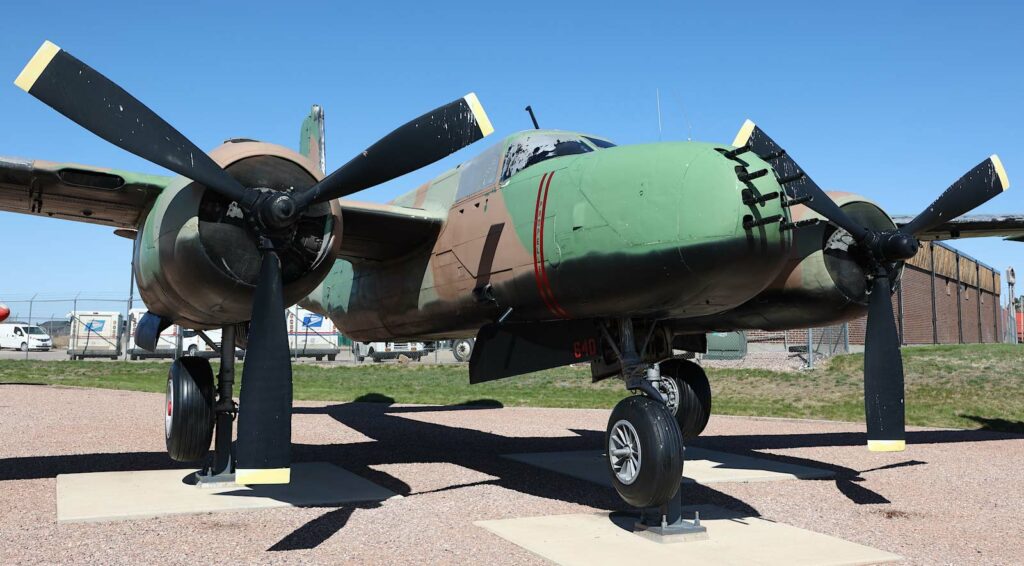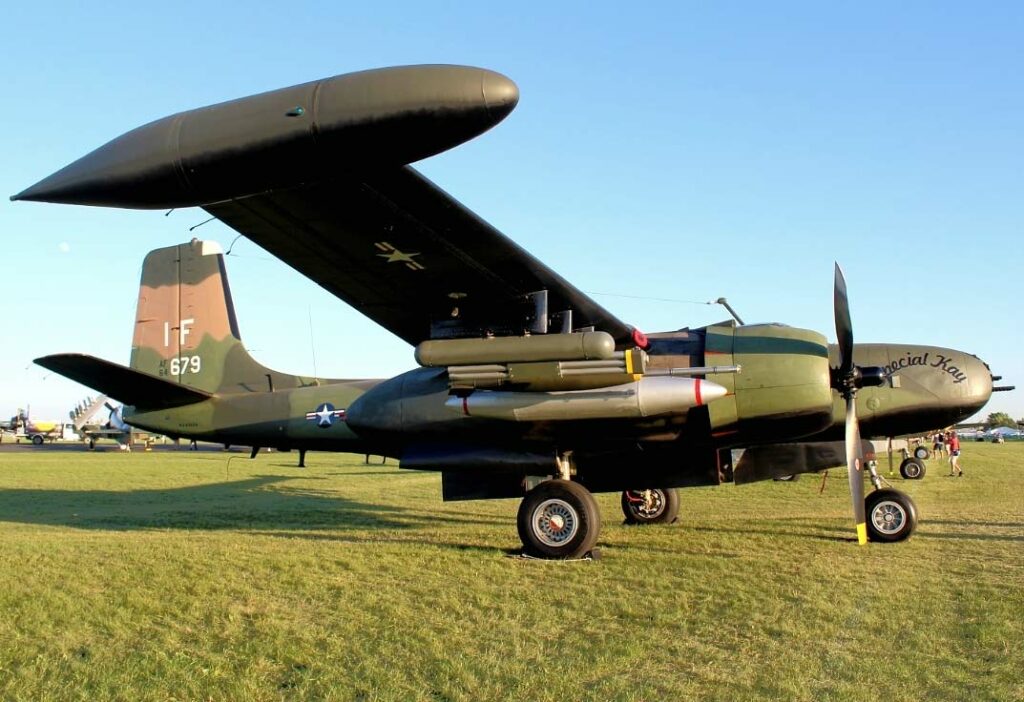The B-26K Counter Invader, an upgraded A-26B, was a robust, twin-engine attack aircraft designed for counter-insurgency and close air support missions.
In brief
The Douglas B-26K Counter Invader, initially designated A-26B, was extensively modified for counter-insurgency operations, particularly in Southeast Asia. This late 1960s variant was equipped with two powerful Pratt & Whitney R-2800-52W radial engines, enhanced armament capabilities, and improved wing and landing gear structures. The aircraft was optimized for low-level, close air support missions, featuring increased bomb load capacity, eight underwing hardpoints, and upgraded avionics, including navigation and targeting systems. Its redesign focused on durability, low-altitude precision, and enhanced firepower, making it a formidable platform for ground-attack missions in rugged terrain and dense vegetation environments.
The Douglas B-26K Counter Invader represents a pivotal adaptation in military aviation, tailored to meet the exigencies of counter-insurgency operations during a period marked by unconventional warfare and guerilla tactics.

History of the Development of the Douglas B-26K Counter Invader (A-26B)
In the early 1960s, the United States Air Force identified a pressing need for a specialized aircraft capable of conducting counter-insurgency operations, particularly in the challenging environments of Southeast Asia. The Douglas A-26 Invader, a World War II-era light bomber and ground attack aircraft, was selected for extensive modifications, leading to the birth of the B-26K Counter Invader.
The development was spearheaded by On Mark Engineering, which had previously worked on modifying A-26 aircraft. The program aimed to enhance the airframe, engines, and armament to support close air support, night interdiction, and reconnaissance missions. The first B-26K flew in 1964, showcasing significant improvements over its predecessors, specifically designed to withstand the rigors of low-altitude tactical missions in the humid and hostile conditions of Southeast Asia.
The aircraft was re-designated as the B-26K to avoid confusion with the Martin B-26 Marauder and to reflect its extensive upgrades. However, due to political considerations and treaty obligations, the aircraft were redesignated A-26A when deployed to Thailand. The nickname “Counter Invader” was aptly chosen, highlighting its role in counter-insurgency operations, although this was not a formal NATO designation.
The B-26K/A-26A’s development was a direct response to the unique challenges of the Vietnam War, representing a shift towards aircraft capable of versatile, tactical, and sustained ground-attack operations in contested environments.
Design of the Douglas B-26K Counter Invader (A-26B)
The Douglas B-26K Counter Invader underwent significant design modifications from its A-26 predecessors. The aircraft was equipped with two Pratt & Whitney R-2800-52W radial engines, each providing 2,500 horsepower, which were more powerful and reliable than the original engines, enhancing the aircraft’s performance, especially in the hot and high conditions of Southeast Asia.
Structurally, the B-26K featured strengthened wings and an improved landing gear system to accommodate increased takeoff weights. This was crucial for carrying a larger payload, including conventional and napalm bombs, unguided rockets, and machine guns. The aircraft’s wings were equipped with eight underwing hardpoints, allowing for a variety of weapon configurations.
The cockpit was upgraded with state-of-the-art navigation and targeting systems, improving all-weather and night operation capabilities. The Counter Invader’s reinforced airframe and enhanced avionics package were designed to maximize survivability and effectiveness in low-altitude, close air support missions.
Despite these enhancements, the aircraft faced certain drawbacks, such as limited maneuverability at low speeds and a relatively high maintenance demand due to its complex systems and aging platform. However, its robust design, significant payload capacity, and low-altitude precision made it exceptionally suited for its intended counter-insurgency role.
Performance of the Douglas B-26K Counter Invader (A-26B)
The B-26K’s performance was specifically tailored to the demands of counter-insurgency warfare. The upgraded Pratt & Whitney R-2800-52W engines enabled a top speed of approximately 323 mph (520 km/h) and a combat range of around 1,400 miles (2,253 km) with external fuel tanks. The aircraft had a service ceiling of 30,000 feet (9,144 meters), although its operational effectiveness was optimized for low-altitude missions.
Comparatively, the B-26K was not designed for high-speed jet-age dogfights but for durability, loitering capability, and precision in ground-attack missions. It outperformed many contemporaries in its specific role, providing reliable, effective close air support and interdiction capabilities unmatched by faster, jet-powered aircraft, which lacked the Counter Invader’s loitering time and payload flexibility.
Variants of the Douglas B-26K Counter Invader (A-26B)
The primary variant of this aircraft was the B-26K, modified extensively from the A-26B Invader. The modifications were so extensive that the revamped aircraft warranted a new designation. However, when deployed to Thailand, they were designated A-26A due to political and treaty constraints. Essentially, the B-26K and A-26A were the same aircraft, differing only in name based on their deployment location.

Military Use and Combat of the Douglas B-26K Counter Invader (A-26B)
The B-26K/A-26A was primarily used during the Vietnam War, providing close air support, interdiction, and counter-insurgency operations. It was renowned for its ability to deliver precision strikes against enemy supply lines, troop concentrations, and fortified positions. The aircraft’s armament included up to 8,000 pounds of mixed ordnance, including bombs, rockets, and machine guns, making it a formidable ground-attack platform.
Its combat service in Southeast Asia demonstrated the aircraft’s effectiveness in a counter-insurgency role, where its robust construction, powerful armament, and long loiter time were invaluable. Despite facing formidable anti-aircraft defenses, the B-26Ks conducted numerous successful missions, significantly impacting enemy logistics and troop movements.
After the Vietnam War, the surviving B-26Ks were retired or transferred to friendly nations, as newer, jet-powered aircraft began to dominate the battlefield. The Counter Invader’s legacy is marked by its adaptability, reliability, and effectiveness in the specialized role it was designed to fill.
The Douglas B-26K Counter Invader exemplifies a specialized adaptation of an existing aircraft platform to meet the specific tactical demands of counter-insurgency warfare. Its design, performance, and operational history reflect a period when air power adaptability was crucial to mission success in unconventional warfare environments. The Counter Invader’s legacy is a testament to the ingenuity and effectiveness of converting vintage aircraft to meet contemporary military needs, showcasing a unique blend of old-world design and modern warfare functionality.
Back to the Special Aircraft section